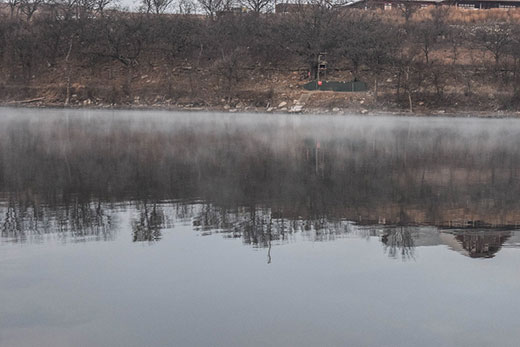
Healthy farm ponds provide fishing, swimming and boating opportunities, as well as a water source for range cattle.
K-State’s Lee outlines options for maintaining pond health
MANHATTAN, Kan. – In rural Kansas, the farm pond is a central part of family life.
Aside from providing a water source for range cattle and other livestock, some ponds provide recreation for family members, including swimming, fishing and even boating. In an emergency, water from the pond may even help to put out a property fire.
All of which, says K-State Research and Extension wildlife specialist Charlie Lee, makes it more important to maintain the health of those ponds.
“I get a lot of calls about aquatic plants causing problems in ponds,” said Lee, who is also an instructor in K-State’s Department of Animal Sciences and Industry. “Too much aquatic vegetation can reduce the enjoyment of fishing, swimming and boating; and provides too much shelter for young fish, which leads to an unbalanced fish population.”
Lee said the plants he hears most about include filamentous algae (which looks like a floating mat on the water’s surface), chara, coontail and cattails. He said when those plants reach the end of their lifespan, they can completely cover the surface, blocking sunlight and reducing oxygen levels.
Then, he notes, “you may end up with a massive fish kill. And the wrong kind of aquatic plants can cause foul odors and reduce the aesthetic value of ponds.”
Blue-green algae are not algae at all, “but are a photosynthetic bacteria found in many ponds,” Lee said. “Their rapid growth is enhanced by phosphorus or nitrogen runoff from nearby agricultural land.” Blue-green algae can be toxic to animals and humans.
“Chemical control of aquatic plants is often the option many landowners prefer,” Lee said. “Unfortunately, chemical control may be risky if the pond has an over-abundance of plants and there is an extended period of overcast skies. If the aquatic plant is not properly identified, control may be ineffective. Plus, chemicals are expensive and are usually not advised during the heat of the summer.”
The key to using chemicals, he said, includes properly identifying the plant, carefully calculating water volume and following label directions. “Success is greater when chemicals are applied earlier in the season,” Lee said. “There are some restrictions on some chemicals when the pond is for livestock use, swimming or irrigation.”
Lee said there are other options, including:
- Management – Limit areas where the water is shallow. Or, Lee said, reduce areas where the water is clear, which prevents sunlight from reaching the bottom of the pond and stops plants from sprouting. Lee said commercial dyes can help to reduce water clarity, or an opaque tarp can be used to cover parts of the pond.
- Biological – Grass carp are known to eat some aquatic plants, though they seldom eat filamentous algae or cattails, Lee said.
- Altering the habitat – This includes incorporating ways to intercept such nutrients as nitrogen and phosphorus before they enter the pond.
More tips on taking care of farm ponds is available for free online from the K-State Research and Extension bookstore. Interested persons can find more than two dozen publications on farm ponds under ‘Environment and Natural Resources.’
